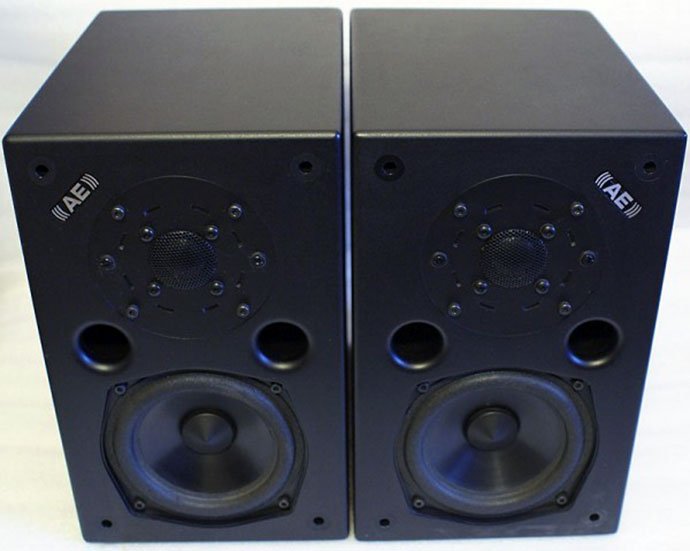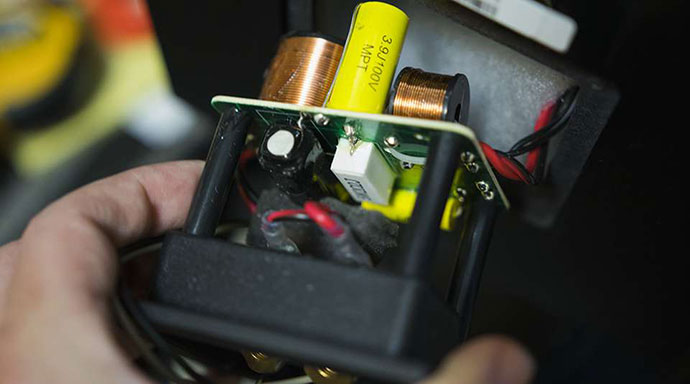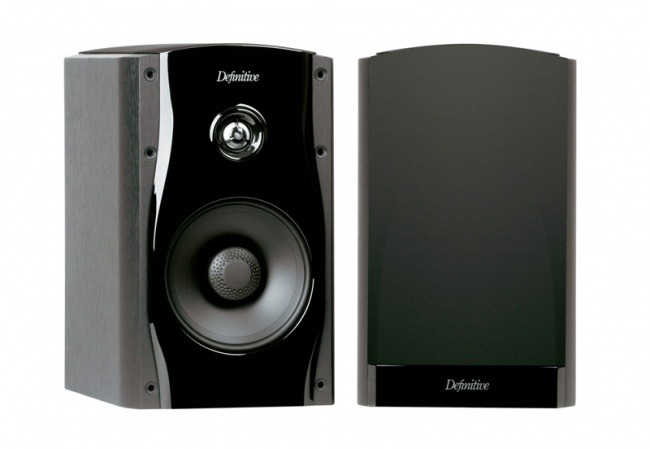The Best Bookshelf Speakers in 2018 – Ultimate Review&Test
We can proudly present a list of the best bookshelf speakers in 2018 for every pocket.
Further below you will find a detailed test of the best bookshelf speakers today, with all data you need, hearing tests and specifications.
The Best Bookshelf Speakers in 2018 List:
Disclaimer: If you purchase through links on our site, we may earn an affiliate commission. Read More
1. Acoustic Energy AE1 Classic Review
Does it make sense to offer to the market a faithful copy of something that its star moments had twenty years ago at the time of galloping technological progress? In the case of an AE1 Classic certainly, do. Because it is a speaker whose level of detail and music is far above its price range.
After Aegis One for Acoustic Energy, there has been a period of the drop in popularity.
And when they are in lack of the ideas for the new products, why not look into their past and give the market a proven product in a new edition. One of their most glamorous products is certainly the AE1, the loudspeaker first introduced in 1988. The AE1 was then extremely popular and commended in the press, followed by a couple of “improved” versions.
In the name of a return to the broad market, Acoustic Energy has decided to offer a copy of its most famous monitor. We have already seen something similar to some of the manufacturers, Rogers, for example, who was re-launched legendary LS3/5 under Chinese ownership. Since things have changed significantly in the last twenty years, such a move could be risky, but the distinctive diversity of the AE1 Classic from the current offer of small speakers makes it a special product on the market.
Speakers that successfully live (or they lived) in the world of professional audiences (as studio monitors) and the hi-fi world are very rare. The first to come to mind is, of course, the legendary studio monitor LS 3/5 according to the BBC specification. AE1 also had a similar destiny, very rare and unique. Connecting the characteristics of a studio monitor and their requirements to sound with the demands of hi-fi enthusiasts is a tough task. The main objection is usually that the sound is pre-analytic, it lacks some warmth, the details in the high part of the spectrum are overwhelming compared to the rest of the spectrum, etc. But if the monitors are well-made they can provide insight into music in a way that rarely the speaker intended solely for the hi-fi market can.
Technical description
Technical specifications on the manufacturer’s pages are exceptionally short and there is nothing more in the material that cames along with the speakers. The box has a magnesium alloy tweeter with a diameter of 25mm, while the bass/midrange is 110mm with a membrane of anodized aluminum. The maximum power the speaker can handle is 200W. The sensitivity is small – 84db, but as it turns out, these small monitors have no problem with a 40-watt amplifier. Impedance is not specified, but according to the measurements in some online journals, its minimum is about 8 Ohms. The box is made of black mat finish and on the backside, there are a couple of single-wired connectors, maybe slightly lower quality than we are used to in this class of loudspeakers. The overall impression of design can be described in one word; studio.
Sound
From a pedigree speaker like these expectations are somewhat bigger and different from others. AE1 already shows its face in the first beats. The piano response to the Tchaikovsky concert for piano and orchestra No.1 is shown extremely clean with a good timbre. In the lowest octaves, though limited in-depth due to its size, it shows exceptional control and firmness in the bass. Details in the high-tech area of the orchestra are all the time present and displayed extremely pure without any kind of grain or any other “artistic” contribution of the speakers, are shown as they are on the record, without any embellishment. The details in the middle part of the spectrum are many and present but still provide a slightly lower level of information than the high part of the spectrum. During the orchestra crescendo, AE1 Classic showed a characteristic that usually fits into the more expensive speakers, the stage stays in its gaps, with minimal degradation in space, even at higher volumes. Of course, with these same crescendos, there is a clear degradation of micro-dynamic relationships. The width of the stage is correct, although it can not be said to fall into the top of the category. With all the control it possesses, the characteristic that builds it up from others is the speed with which it can convey complex information to such a large number of orchestra performers.
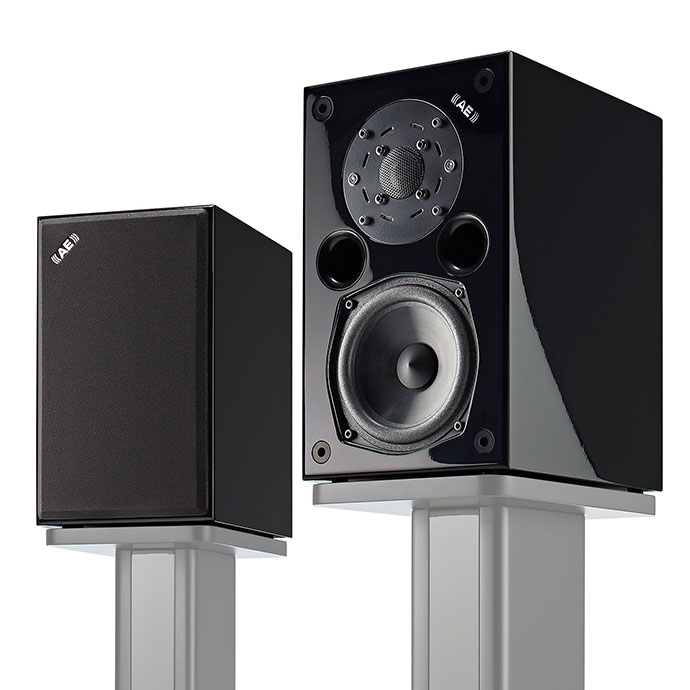
After AE1 proved to be exceptionally good with big orchestras, a material that is very demanding for such a small speaker, we played a small band led by an exceptional vocalist Rebecca Pidgeon. The speaker only confirmed previous impressions. The vocals are reproduced very pure and clear. The vocal positioning was done correctly with the natural separation relative to the position of the rest of the band. A slightly smaller stage width which was obvious with the previous orchestral record is now a little bit more obvious. The timbral correction and reproduction of the material as it was recorded comes to expression. The depth of the stage is following the other two dimensions. For testing, until now a fairly defined and fast bass area was served by the Massive Attack album, Mezzanine.
Artificial basses that come extremely deeply set great demands on these small monitors. The bass thunderstorm in the bass area can not be expected from such a small boxes, although considering the size of the AE1, it goes extremely deep, but what is surprising is the ability not to lose the definition and remains assembled no matter what the material demands and leaves the impression that the speaker is still in the cabaret seat regardless of the restriction at the lowest frequencies.
Conclusion
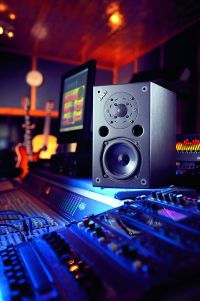
AE1, although designed for some twenty years, is still a very up-to-date product, and at this time, it is, and unique in the market. No loudspeaker, no AE1, stacks are not in the top, but when it comes to small monitors, nothing comes without a charge. The ability to display a lot of information from the signal coming, to keep all aspects of the sound image at dramatic dynamic ups, is beyond the category. With the real rest of the system, where you need to make sure that the high signal input signal is not too hard, AE1 is a very exciting choice.

Technical Specifications
Bass/Mid Driver: 110mm ceramic sandwich aluminum cone, 32mm edge-wound voice-coil
Tweeter: 25mm magnesium alloy dome
Crossover: Symmetrical third order at 3kHz
Power Handling: Compatible with amplifiers rated at up to 200 watts into 8 Ohms
Frequency Response: 70Hz – 22kHz ±3dB
Sensitivity: 86dB for 2.83V at 1m
Nominal Impedance: 8 Ohms
Total Harmonic Distortion: Typically less than 0.3%, 200Hz to 20kHz
Power Compression: Less than 1dB for 16dB gain at 250Hz
Dimensions: 295 x 180 x 255mm (HxWxD)
Weight: 7.5kg (single, unpacked)
Finishes: Piano black, very limited quantities available
2. Elac Debut B5 Review
Elac Debut B5 is a brand new vision in which Andrew Jones designed speaker units, crossovers and the box itself
Elac Debut B5 is a brand new vision in which Jones designed speaker units, crossovers, and the box. Speakers are designed in California in a brand new environment that Jones equipped according to their wishes and needs, and to reduce costs production is entrusted to partners in China. That allowed him to in other more important places go with somewhat better parts and better and more expensive solutions. The spheroidal horn tweeter unit is made of silk and the diameter is 2.5 cm, and it has pretty much deep-seated drive. Such a procedure allows a relatively simple construction to direct the sound waves in an optimum manner, while also avoiding the refraction of the box. Bas and mid-range are covered by a 13 cm diameter unit made of aramid fibers for which the constructor quotes clear advantages in the strength-mass relation and damping ability concerning possible alternations to the units created of treated paper or polypropylene.
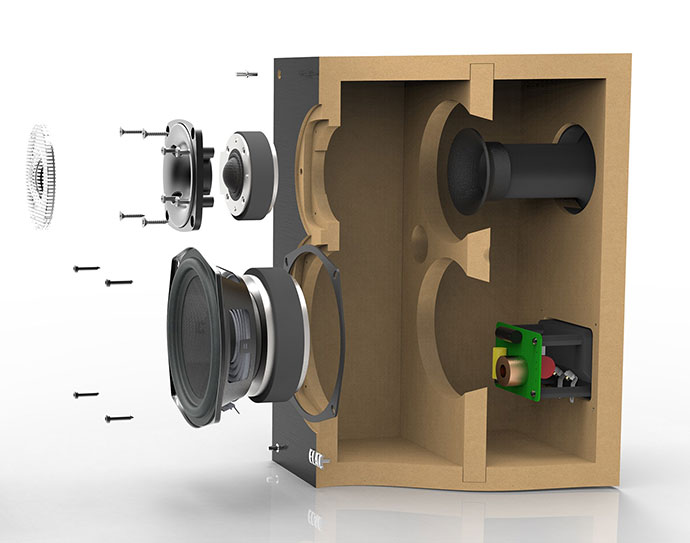
The company believes that the unit is very flexible related to the rest of the structure and additionally owns heard benefits in width spectrum and good impulsive reaction thanks to a, particularly powerful magnet. The crossover is made of seven elements and cutting frequency of 3,000 Hz. Parts of the crossover are indeed very high quality for this class of loudspeakers as well as a pair of metal connectors with which the connection of the speaker cables was easy and without any greater need for a powerful twist to make solid contact.
The box is made of MDF and on the first look is not too massive and convincing, and without internal struts which were left out in the first two models in the series. Among others features we need to mention “dual flared” bass reflex port on the back of the speaker, protective grid (which we removed during the test) and the basic numbers that talk about 85 dB sensitivity, impedance 6 ohms and the weight of each box of 5.2 kg.
- Custom Drivers
- Woven Aramid-Fiber Woofer and binding posts is 5-way metal
- Deep-Spheroid Custom Waveguide and Intricate Crossover.Tweeter:1x 1 inch...
- Sensitivity: 85 dB at 2.83 v/1m , Woofer: 1 x 5.25-inch woven aramid-fiber...
- Nominal/peak power handling: 50 / 120 wpc , Nominal impedance: 6 Ω;...
Hearing test and conclusion
The last few constructions which are signed by Andrew Jones and which I heard were very good. Preparations for listening included placing the speakers on the stands and after a few minutes of listening removing the grills that are closed the sound picture and made the sound construction slightly unconnected. At that point, things came to place. I started considerably (Charlie Haden, “Private Tapes “) at low volume and in turn got a pretty full sound with formed spatiality, which had only a little fewer dynamics. With a volume turned up sound got needed dynamics and solid contours and painted a good space in width and excellent depth perspective. At that point, my expectations grew up and tried with a small movement in space to draw even more from the speakers. The best results were achieved with little twisted speakers according to the listening place about two feet away from the walls and with a slightly lower position of the head. Then almost all the parameters we can expect from the speakers in this class have come to the right balance. Listening to extraordinary record(The Band / “Music From the Big Pink”, Original Master Recordings) it has been added a fine alignment of wire and over-precision in instrument volume projection. Loud listening did not cause stress in the construction, but somewhat hurt definition and focus of the bass areas which slightly dampened medium microdynamics. Classical music of the string quartet discovers a little bit of retired upper treble area but added a lot of space and very natural timbre. Compared to the Elac Debut 5 price we almost had no objections.

Those who want to get the maximum out of these speakers need to put them in space and on quality stands. In this case, the speakers will deliver full, dynamic and well-connected sound with enough quantity of detail and good space. Andrew Jones has not lost the design skills of the speakers in which it is necessary to meet the compromises. It is huge happiness to do the job he likes. Skill, pleasure and remarkable feeling for music has been felt for years in the work of the designer through the sound of his speakers. The Elac Debut B5, on the other hand, was a great substrate for a great comeback.
Technical Specifications
Speaker type: 2-way, bass-reflex
Tweeter: 1 x 1-inch cloth dome
Woofer: 1 x 5.25-inch woven aramid-fiber cone
Crossover frequency: 3,000 Hz
Frequency response: 46 to 20,000 Hz
Sensitivity: 85 dB at 2.83 v/1m
Recommended amplifier power: 30 to 120 WPC
Nominal/peak power handling:50 / 120 WPC
Nominal impedance: 6 Ω; minimum 5.4 Ω
Binding posts: 5-way metal
Magnetic shielding: No
Cabinet finishes: Black brushed vinyl
Accessories included: Removable fabric grille
Height: 12.8 in / 324 mm
Width: 7.9 in / 200 mm
Depth: 8.7 in / 222 mm
Net weight (each): 11.5 lb / 5.2 kg
3. Monitor Audio Bronze BX2 Review
Just as the right art is to make a top speaker regardless of price, so it’s a skill to make a cheap speaker that sounds good. The BX2 sounds good.
In the audio world the phrase “you get what you pay for” can often be quite literally understood. If you spend a lot of money on the system the chance is that it will not play badly. If you did not take care of the system components synergy and carefully examine and test each of its components, you probably have not pulled the maximum out of it. The real art of composing audio systems is to get as much music for as little money as possible.
Overtime to the market comes a component emerging from the average relationship gained/invested. The example has a variety in all component types, NAD C320 Integrated Amplifier, Cambridge Audio Cheap CD Players, Wharfedale Diamond 8.1 Speakers and what is important for this test – Monitor Audio Bronze B2 speakers that set the standard for the other speakers of that class.
After a couple of years came the new version, equally successful, BR2 and now we finally have the third incarnation – these BX2 speakers on the test. The Bronze Series is the cheapest series in Monitor Audio offer and consists of two stand-alone models and two designed for shelves. The differences compared to the last series are visually small and as the manufacturer writes in promotional materials it is just about fine-tuning the entire production process by using better materials and better quality parts.
Bronze BX2 is not a small loudspeaker – in range of similarly priced speakers, it is pretty larger. Regardless of the higher volume, the loudspeaker on the stands looks quite elegant, especially in the color of dark wood. As with all speakers of this class and size we have a bass reflex box. The hole in this model is on the front side while on the back are gold-plated connectors for bi-wiring.
The embedded tweeter is already well known, an aluminum membrane coated with a ceramic layer, to achieve high strength of the material and thus a high resonance frequency. This technology in Monitor Audio is called C-CAM. According to the official manufacturer’s materials, the resonant frequency of the membrane is close to 30kHz. The tweeter diameter is 25mm. The 165mm diameter bass/midrange was also made based on C-CAM technology. The official materials state that a coil and a reinforced magnet have been improved regarding the last series to provide more linear responses throughout the spectrum covered by this unit. The way of the sound signal on the crossover is shortened to the previous version.
That is not all of the improvements made – the bass reflex has been changed and is now made of relief plastic to accelerate the movement of air through the opening itself. We had the opportunity to see a similar concept on Bowers & Wilkins speakers at a slightly higher price. No visible screws are holding the speaker units. Audio Monitor decided to be significantly different from most of the other speaker manufacturers. Instead of making the speaker units tightened for the front panel as it is common in the BX2 they are fixed to a rear panel bracket with a long screw that ties them to the front panel housing. With this principle in Monitor Audio, they would like to remove one of the sound coloring sources that make the usual connection.
The BX2 speaker units do not have a direct connection to the front panel. The power that these speakers can receive is limited to 100W at the stated impedance of 8 ohms. Sensitivity is high 90 dB that allows these loudspeakers to work very well with weak amplifiers. The hearing test showed that 40W is more than enough to control the loudspeaker at higher volumes.
- Powerful bookshelf speaker
- New C-CAM gold dome tweeter
- New 6-1/2" bass driver with concave 'dished' C-CAM cone profile
- Rigid 18mm MDF construction throughout, employing radial and cross-bracing...
- Premium quality vinyl veneer finishes in Black Oak and Walnut
Sound
The sound of all the Audio Speaker Monitor I had a chance to test has a clear common background and BX2 is no exception. The sound of their speaker units is truly recognizable no matter what the series is doing. With the jazz standard “Take Five” performed by Dave Brubeck, as well as the latest versions of the Bronze series, the BX2 has a very fast and rhythmic sound. The cleanliness and detail of the high part of the spectrum were great when considering the price of the speaker. The middle part of the spectrum is the same as the treble – detailed, fast and open. The drummer’s solo section revealed a very good control and bass speed.
Bass goes deep enough, but with a relatively large box, it could be expected to go deeper. With vocal jazz, it reveals new sound dimensions especially concerning timbral correction and sound transparency. The voice is reproduced very purely with natural colors and volumes. The width of the stage is one of the best I’ve had the chance to hear in this class, the depth is not as high as the height, but it’s really hard to expect in its class. The album of American rockers Queens of the Stone Age sounded very good. The loudspeaker is capable of playing at higher volumes without greater degradation of the sound image and its speed and rhythm are very pronounced in such material.
The high part of the spectrum is just as opened as needed but it has never been hard or overwhelmed. Here it should be borne in mind that the rest of the system must match the speakers. A somewhat warmer character of the amplifier or speaker cables is welcome to make the sound very pleasant for long listening. Listening to the symphony orchestra’s recording just confirmed the impressions gained before, the amount of detail that is capable of providing the BX2 is excellent throughout the spectrum. Stage width is very well done with enough space between the artist to avoid unwanted sound jamming. The presentation options of those fine details are in line with the class, perhaps even higher than the price suggests. The bass area is very firm and fast, again not with too much volume, just the way it is.
Conclusion
Just as the right art is to make a top speaker regardless of price, so it’s a skill to make a cheap speaker that sounds good. The BX2 sounds great. High sensitivity means that almost all the amplifiers in the class can be driven without any problems. Accommodation is also not a problem and is not too demanding, but they need to be placed on good stands to get the maximum out of them. When choosing other components, make sure that they are not too bright in character as in conjunction with the fast and detailed highlights of the BX2 spectrum the details would not turn into something unwanted. Objections? Of course, there are, space could be better, deeper, but this is not too serious when pricing is concerned. The BX2 is one of the most rounded speakers for its price.
Technical Specifications
Frequency Response: 42Hz – 30kHz
Sensitivity (1W@1M): 90 dB
Nominal Impedance: 8 Ohms
Power Handling (RMS): 100 W
Recommended Amplifier Requirements: 30 – 100 W
Cabinet Support: Front ported bass reflex. HiVeII port technology
Crossover Frequency: 3.2kHz
Drive Unit Complement: 1 x 165mm (6 1/2″) C-CAM bass mid-range driver
1 x 25mm (1″) C-CAM Gold Dome tweeter
External Dimensions (H x W x D): 350 x 185 x 255 mm
13 3/4 x 7 5/6 x 10 1/16 inches
Weight (each): 5.84 Kg (12.8 lb)
4. Wharfedale Diamond 10.1 Review
More complete than previous model 9.1, Diamond 10.1 is a brilliant speaker for jazz, pop and electronic music, which can be enjoyed for a long time without effort. However, one should be careful with the choice of electronics.
Wharfedale has, despite frequent ownership changes, has been synonymous with quality budget speakers for 75 years. Diamond models will celebrate thirty years of success next year, and the 10th series, judging by the second smallest model 10.1, could continue the tradition.
The dimensions of the boxes remained the same concerning the predecessor 9.1, counting the curved sides as well. But two bass reflexes were moved to the back of the box and in Wharfedale, they measured that this operation helps the speaker go to a low 48 Hz. There is also a change in the construction of a box that is reinforced on the inside by new compartments for eliminating internal standing waves. The neodymium tweeter of the soft-dome has a wired shield that also serves as a diffuser for high tones. The glossy aluminum frame around the kevlar membrane is an effective “fashion” detail that covers a special polymers basket. The speaker cartridge is shallower than before because in Wharfedale it is considered that this reduces the effects of reflection movements on the back of the membrane and distortion. The front panel is covered with thick piano-style plastics and the contrast between dark membranes and “silver”, the roughly-shaped frames around them look handy and expensive. Just like bi-wiring of gold-plated speaker terminals. Diamond 10.1 is a real pleasure for the – the most beautiful design of all Diamond Series.
Sound
“Take Five” Dave Brubeck is always grateful for the start-ups. The Diamond 10.1 seemed to be a well-balanced, loudspeaker with a warmer character. Saxophon of Paula Desmond was natural, relaxed, but in that extraordinary shot, there was a little bit less of “air” than we used to. The change of cables (from Qed to Tara Labs) has brought an improvement, just like turning the speaker to the listener. The bass is well controlled, its extension is surprisingly deep even when the speakers are quite distant from the rear wall.
- Soft dome tweeter delivers crystal clear high frequency definition up to...
- 5" Kevlar bass driver & twin rear-firing ports for astounding bottom end...
- Curved side panels reduce panel flex and cancel internal standing waves
- Full internal cross-bracing for reduced enclosure vibration
- Pair of speakers
Closer to the wall gets even stronger bass but a bit of focus is lost and the seamless connection between the lowest and the middle is distorted. In Beck’s “Lonesome Tears” speaker has been shown in its musicality, though its ultra-low bass waves have been influenced on minor control issues. The instruments are separated, well laid out in the space of a luxurious stereo image, but there are limitations. When the song “complicates” with the layers of string instruments and the middle of the spectrum becomes buried the instruments are somehow closer and more difficult to recognize in the space. Confirmation that Diamond 10.1 complied with its class and price can never do wonders for more demanding designs came through Brahm’s 4th Symphony; Instruments through the system sound timbrel faithfully with a little bit of lack at the extremes, in the full rushes of the orchestra the speaker rein back as it should, but it is too much to expect to completely separate the instruments and provide a virtual deep impression of the great orchestra lines. That’s why with simpler and electronic recordings Diamond provides a “diamond” sound. The introductory bells of the “Hells Bells” from Australian hard-rock band AC/DC spread their bells beyond the outside edges of the speakers and give a sense of size.
The guitar riffs and the sound of the cymbals and drums swam with precision and depth of perspective while the “toothed” voice of Brian Johnson floated above the center of the speaker. In a word, the new Wharfedale boxes have made an exciting rock band even more energetic. A similar compliment could be pronounced for the reproduction of electronic music. In Norway’s Royksopp duo, the lowest part of the spectrum is not like Beck’s placed speaker to temptation, the extraordinary control of the deep bass in the pulsating “49 percent” proved to be an excellent foundation for a fast, attractive middle segment and “smooth” but transparent high. And as the amplifier volume goes up more Diamond 10.1 works better.
Conclusion
Diamond 10.1. retained the main characteristics of its predecessor model 9.1. Diamond 9.1 has more pronounced darkness, 10.1 will also sacrifice the details for a warmer sound, but the more representative mid-range spectrum is approaching the neutral character. Second, the 10.1 with two bass reflex holes provides more space to accommodate the ideal deep-tones level by bringing closer/further to the rear wall. All in all, 10.1 is a more complete speaker, with better cohesion of the sound spectrum and a bass area that imposes control and volume. A great loudspeaker for jazz, pop-rock and electronic music that can be enjoyed for a long time without effort. However, one should be careful with the choice of electronics. The amplifier of the lighter character of the used Marantz, with an explosive “attack” and more power, could draw even a more out of a talented Diamond.
Technical Specifications
Format: Standmount
Bass/Mid Driver: 125mm
Tweeter: 25mm
Suitable Amplifier Power: 20-100 Watts
Impedance (Nominal): 6 Ω
A/V Shield: Yes
Sensitivity: 86dB
Nominal Frequency Range: 48Hz – 24kHz
HF Limit (-10dB): 44kHz
Crossover Frequency: 1.8kHz
Dimensions (H*W*D): 296*194*278 (mm)
5. Definitive Technology Studio Monitor 55 Review
Definitive Technology products on our market have been for some time, and we have been able to see and test some of their interesting products. As compared to other audio producers, Definitive Technology constantly offers a few different solutions, such as dipole construction, active bass units, and a few more solutions that are rarely offered by manufacturers.
The offer of this manufacturer is extremely wide both in price and in purpose. From high-class speakers, through built-in home cinema to soundboards for tablets. We have prepared a test for the Studio Monitor 55 bookshelf speakers.
Most speakers of Definitive Technology have something in them that distinguishes them from the majority – the same thing is with Studio Monitor 55. It seems to be the classic design of small speakers. If we look at the speaker tests back in the last ten years, very few of them are not a bass-reflex, and especially if we look at the small speakers – here and there comes something out of the standard. The Studio Monitor 55 is high quality and well-designed speaker available in black finish only.
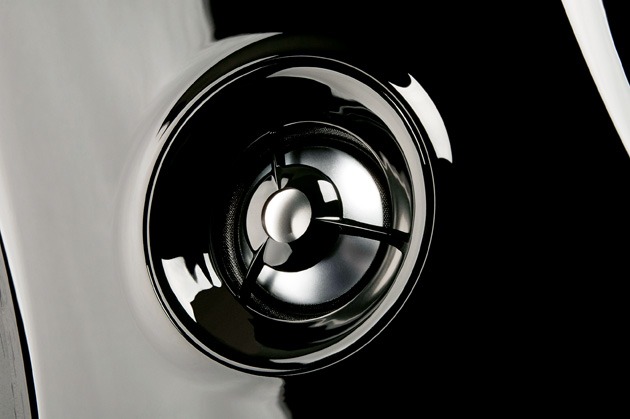
The front panel is high gloss black while the sides are matte black finish. On the front, we find a bass/mid-frame with a very specific design with a large phase extension for better sound dispersion 16.51cm in diameter. The tweeter is aluminum-coated with a ceramic layer and 25.4mm in diameter. What makes this speaker different from the rest of the market is that the box is not a bass reflex construction. On the upper side, there is a large oval membrane of height 25.40cm and a width of 15.24cm.
It looks very similar to the old Kef oval membrane. This membrane is passive, meaning that no coil and magnet drives it, but its movement is related to the movement of the bass unit.
- 6-1/2" BDSS mid/bass driver
- Second generation pure aluminum dome tweeter
- Bi-amp/bi-wire all-metal 5-way binding posts
- Single Speaker - Sold Individually - Purchase Two for a Pair.
The speaker box is also hermetically sealed so that the movement of the bass unit causes the passive unit to move. When the bass/midrange is drawn, the passive radiator rises and vice versa. Such a construction is not a novelty and we have already seen the speaker of this design through history but today it is rare, especially at a given price range. An example of such a top-of-the-line speaker design but at a higher price was Sonus Faber Electa Amator 2.
In theory, this approach has advantages over control, strength and bass efficiency, but of course, this depends largely on the specific performance of a particular speaker. Of the other technical features, it should be mentioned that this is a very sensitive speaker, whose declared sensitivity is 90 dB at the impedance of 8 ohms. The maximum power that this speaker can receive is 225W. The height of the box itself is 33.02 cm, width 20 cm, depth 31.43 cm, while the weight of a speaker is 6.8 kg.
Sound
Studio Monitor 55 has spent more time in the listening room. After the initial tuning that lasted longer than usual, which is commonplace with speakers with an aluminum tweeter, a test has started. It has been shown that the speakers are not difficult to accommodate in space, which can be largely due to the lack of bass reflection of the opening so that they can sound well in smaller spaces or in cases where the owner can not place them away from the rear and sidewalls.
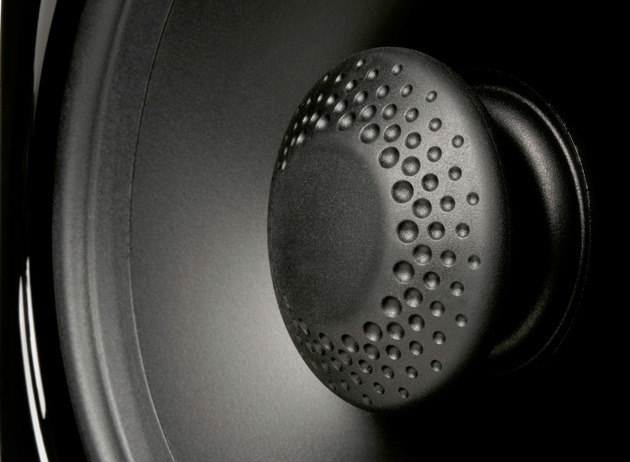
The first listening material was Kind of Blue, Miles Davis. The sound of his trumpet sounded biting and very well defined with a great echo. The aluminum tweeter is capable of transferring a lot of detail spaced in the space. The midfield area is well defined and each performer has a clear place on the stage. The minimum presence of coloration throughout the spectrum is one of the strongest trumps of this speaker. When listening to the symphonic orchestration SM55 showed how much detail it can deliver and how precise it is.
The stage size is very good in all dimensions and especially in-depth compared to other competitors of similar price. The timpani strikes this speaker reproduces with exceptional strength and speed, and no depth is far behind. Even in the larger room this speaker has been able to fill in the sound and provide enough bass. When listening to amplified and computer-generated music SM55 has demonstrated that it can handle without a problem with such a type of material. His great speed and a very good definition made this material fun for listening. But when listening to this often poorly produced material, it turned out that the aluminum tweeter sometimes sounds tough.
Conclusion
Studio Monitor 55 is an extremely interesting speaker for several reasons. First, his construction is different from the rest of the competition. Because of this construction, it is capable of delivering the sound that is something new in this price class. With the proper electronics, which is just important not to be too bright, can provide a lot in very different listening conditions and fill a larger room with sound. And because of its lively character, it is pretty good with all kinds of music and even movies.
Technical Specifications
Total Frequency Response: 32 Hz – 30 Hz
Nominal Impedance: 8 ohms
Height: 13″ (33.02 cm)
Width: 7.875″ (20 cm)
Depth: 12.375″ (31.43 cm)
Weight: 15.45 lbs (7.01 kg)
Driver Complement: (1) 6.5″ (16.51 cm) d (Round) BDSS Bass – Mid/Woofer
(1) 10″ (25.4 cm) h x 6″ (15.24 cm) w (Oval) – Bass Radiator
(1) 1″ (2.54 cm) d (Round) – Tweeter
Recommended Amplifier Power Per Channel: 20 watts – 225 watts
Speaker Inputs: (2) Pair of 5-Way Binding Posts – Gold Plated
This is the list of the top 5 bookshelf speakers in 2018. It is up to you to choose and buy a new bookshelf speaker by very reasonable prices, as you may see.

